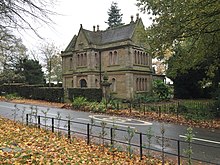Ralph Sneyd (1793–1870)
Ralph Sneyd | |
|---|---|
 Engraved portrait of Ralph Sneyd from 1842 | |
| Born | 1793 |
| Died | 1870 |
| Occupation | landowner |
| Parents |
|
Ralph Sneyd (1793–1870) was an English landowner in Staffordshire, now best known for the rebuilding of Keele Hall. He was also an ironmaster, coalowner and railway developer, and was High Sheriff of Staffordshire in 1844.[1]
Early life
He was the eldest son of
Mr. Sneyd had been a great courtier when he was a boy at Eton. His parents lived at Windsor when his father was attached to the court. George III. had given him a Latin Grammar, and he was quite an ardent admirer of that Monarch.[5]
Sneyd matriculated at Christ Church, Oxford in 1811.[3] A friend from school and college days was John FitzGibbon, 2nd Earl of Clare, with whom Sneyd kept up a long and active correspondence.[6] Sarah Wedgwood, widow of Josiah Wedgwood, encountered Sneyd socially in 1813, and wrote in a letter
We had a good deal of literary conversation, as Mr Sneyd has a very pretty smattering of literary topics and a good deal of taste, though a little affected [...][7]
In 1817,
In an 1823 by-election for
Landowner

Sneyd inherited the Keele Hall estate from his father in 1829. Walter Sneyd had brought down a heavy burden of encumbering debt on the land from the beginning of the 19th century.[14] Ralph brought in Edward Blore to work on buildings that are now part of Keele University, in 1830–1833.[15] He developed the garden from about 1830, planting on a large scale, and was noted particularly for his use of crosses of Rhododendron arboreum.[16][17] He brought in William Sawrey Gilpin from the start to advise on his gardens, as he wrote to Agar-Ellis in September 1829.[18]


Buying further land, Sneyd had purchased over 2,000 acres (810 ha) by 1848, taking on debt.
In 1848 Sneyd on the recommendation of
Sneyd had Anthony Salvin remodel Keele Hall over the period 1854–1860, a well-regarded conversion in line with Sneyd's bachelor tastes.[30] In 1858 he recommended Wheatstone's House Telegraph to a friend.[31]
Collector
Sneyd was a client of the antique furniture dealer
In common with
Legacy
Sneyd was unmarried, and on his death, the Keele Hall estate passed to his brother Walter; and then to his nephew Ralph Sneyd (1863–1949).[37] The Hall was rented by Grand Duke Michael Mikhailovich of Russia from 1901 to 1910.[38]
The Keele Hall library was put up for auction in 1903, as Walter Sneyd's collection of illuminated manuscripts and early printed books. Many of the manuscripts passed to Charles Fairfax Murray.[39][40] The Johnson's Dictionary came up for sale in 1927.[41]
Notes
- .
- History of Parliament Online. Retrieved 20 May 2020.
- ^ Alumni Oxonienses: the Members of the University of Oxford, 1715–1886. Oxford: Parker and Co – via Wikisource.
- ^ The Gentleman's Magazine and Historical Chronicle. E. Cave. 1829. p. 84.
- ^ Bowles, T. G.; Fry, O. A. (1882). Vanity Fair. Vanity Fair. p. 5.
- ^ a b John Rylands Library (1970). Bulletin of the John Rylands Library. Kraus Reprint. p. 297.
- ^ "RECORD: Litchfield, H. E. ed. 1904. Emma Darwin, wife of Charles Darwin. A century of family letters. Cambridge: University Press printed. Volume 1". darwin-online.org.uk. pp. 76–77.
- ^ Granville, Countess Harriet (1894). Letters of Harriet, Countess Granville, 1810-1845. Longmans, Green. p. 133.
- ^ "Staffordshire 182-1832, History of Parliament Online". www.historyofparliamentonline.org.
- ^ "Honiton 1820-1832, History of Parliament Online". www.historyofparliamentonline.org.
- ^ "Agar-Ellis, Hon. George James Welbore (1797-1833). History of Parliament Online". www.historyofparliamentonline.org.
- ^ "Fortescue, Hon. George Mathew (1791-1877). History of Parliament Online". www.historyofparliamentonline.org.
- ISBN 978-0-19-821313-0.
- JSTOR 2596010.
- ISBN 0-7195-3328-7.
- ^ Keele University. "Grounds". Keele University.
- ^ Gardeners' Chronicle. Haymarket Publishing. 1875. p. 622.
- ^ Goodway, Keith (1986). "Landscapes and Gardens at Keele 1700-1900" (PDF). keele.ac.uk. University of Keele. p. 13.
- ^ Childe-Pemberton, William Shakespear (1909). Life of Lord Norton (Right Hon. Sir Charles Adderley) 1814-1905, statesman & philanthropist. London: J. Murray. p. 35.
- JSTOR 2596010.
- ^ "A Closed Village, Keele Parish Online". keeleparish.org.
- ^ Keele University. "Brief history". Keele University.
- ISBN 978-1-4456-7788-0.
- doi:10.1093/ref:odnb/52538. (Subscription or UK public library membershiprequired.)
- JSTOR 40273204.
- ^ Goodway, Keith (1986). "Landscapes and Gardens at Keele 1700-1900" (PDF). keele.ac.uk. University of Keele. p. 19.
- .
- ISBN 978-1-4456-2742-7.
- ISBN 978-1-4456-2742-7.
- doi:10.1093/ref:odnb/24585. (Subscription or UK public library membershiprequired.)
- JSTOR 3825912.
- ISBN 978-1-60606-641-6.
- S2CID 164095355.
- JSTOR 40859513.
- JSTOR 42616206.
- JSTOR 41829587.
- ^ "Sneyd Family Papers - Archives Hub". archiveshub.jisc.ac.uk.
- ^ University, Keele. "A Romanov love story at Keele". Keele University.
- ^ "Sales of Books and Pictures". London Evening Standard. 21 December 1903. p. 6.
- ISBN 978-0-521-15646-2.
- ^ "Johnson's Dictionary". Staffordshire Sentinel. 3 November 1927. p. 7.
